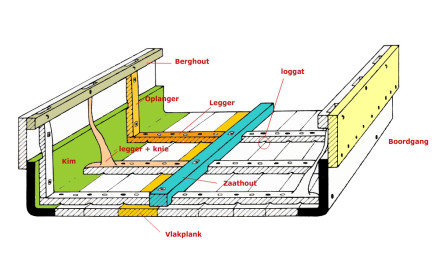History
De Woerden 1 was discovered in 1979 in Woerden. The wreck was reused as part of the bank protection. About 10 meters of the wreck have been excavated and documented from bow to the mast track. The rest of the Woerden 1 is protected in situ.

The length (29.6 meters = 100 Roman feet) is derived from the mast-bow ratio, which makes up approximately a quarter of the total length.
The maximum width was 3 meters (10 Roman feet).
The ship was clinker built and the frames were placed in pairs. The mast block was fastened on an extra wide frame. The bow consisted of one piece of pointed shaped wood. The wood of the Woerden 1 was felled after 169 AD. Behind the mast was a shelter for the crew with a fireplace of roof tiles.

Date
Pottery found under the wreck indicate a date in the last quarter of the second century AD. Shoe soles found in the wreck, point to a date in the third century. The ship must therefore have sunk at the start of the third century AD.
Cargo
Archeo botanic samples taken from the Woerden 1 suggest that the cargo consisted of grain from the Belgian loess region
Description
Status
Partly preserved ex situ , partly preserved in situ.
References
- Brouwers, W. , Jansma, E. Manders, M. (2013).
Romeinse scheepsresten in Nederland.
Archeobrief 4. - Haalebos (1997).
Een Romeins graanschip in Woerden.
jaarboek Oud-Utrecht.